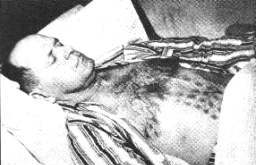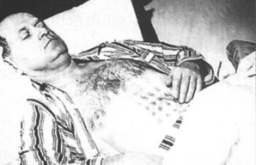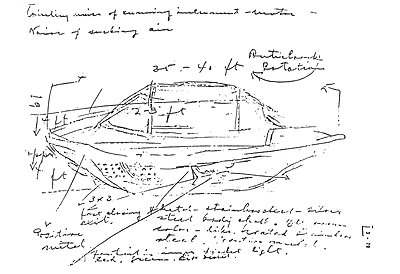
|

|
Above: Photograph of Stephen Michalak showing geometric pattern burned onto his body by the exhaust gases of an alleged UFO. Mr. Michalak's burns where treated but continued to re-appear for many years after his encounter with a mysterious craft in the Canadian wilderness.
During Victoria Day week-end, Canadian Stephen Michalak of Winnipeg, a mechanic by trade, decided to do some prospecting in the Whiteshell Provincial Park. Michalak was an amateur geologist and had been prospecting in the area many times. Others had found several quartz veins near Falcon Lake that were associated with silver deposits, and Michalak had himself found a few promising sites. So, on May 19, 1967, he traveled from Winnipeg to Falcon Lake, where he spent the night in a motel on the Trans-Canada Highway.
Michalak left his motel at 5:30 that morning and headed north into the wilds of the park. At about 9:00 a.m. he found a quartz vein near a small stream. At 11:00 a.m. he ate lunch, then continued to examine the quartz formation. At 12:15 p.m. Michalak's concentration was disturbed by the cackling of some geese. He looked up and was surprised to see two red, glowing cigar-shaped objects descending at a forty-five degree angle. As they came nearer, their appearance became more oval and then disc-shaped.
As he watched, one of the objects stopped and hovered, while the other one descended and landed on a large, flat rock about 160 feet away from him. After a few moments the object still in the air departed, changing from red to orange to grey as it flew into the west and disappeared behind the clouds. The object on the ground also turned from red to grey and finally to the color of "hot stainless steel" surrounded by a golden-hued glow. He had been wearing welding goggles while chipping at the quartz to protect his eyes from flying rock fragments, and now they served the additional purpose of protecting his eyes from a brilliant purple light that was shining through openings in the object's exterior. The object was making a hissing sound and a whirring noise, and it gave off a sulphurous smell.

Sketch by Steven Michalak. |
For several minutes, Michalak stayed where he was and sketched the object. After about half an hour, a door opened in the side of the object, revealing a lighted interior. Michalak decided to move closer, and when he was approximately sixty feet away from the object, he began to hear two voices over the other sounds coming from the object.
Believing that the object was a secret experimental American craft of some sort, Michalak called out in English. There was no response, so he tried Russian, German, Italian, French, Ukrainian, and then English again. There was still no response.
Summoning his nerve, Michalak approached the open door and stuck his head inside. There he saw a maze of lights on what appeared to be a panel, and beams of light in horizontal and diagonal patterns. There was also a cluster of lights flashing in a random sequence "like on a computer."
Not seeing anyone, he pulled back and waited. Suddenly, three panels slid together, closing the opening completely. Michalak then examined the outer surface of the object, noting that it was like highly polished colored glass with no breaks or seams in its surface. He touched it, and it melted his glove.
Without warning, the object moved, and something like an exhaust vent was now in front of him. It was about nine inches high by six inches wide, and contained a uniform pattern of round holes, each about 1/16 inch in diameter. A blast of hot gas shot from these holes onto his chest, setting his shirt and undershirt on fire and causing him severe pain. He tore off his burning garments and threw them to the ground. He looked up in time to see the craft depart like the first, and felt a rush of air as it ascended.
After the object was gone, Michalak noticed a strong odor of burning electrical insulation along with the sulphurous smell he had noticed earlier. Some moss on the ground had been set on fire by his burning shirts, and so he stamped it out.
The spot where the object had landed looked as if it had been swept clean, but piled up in a 15 foot circle was a collection of pine needles, dirt and leaves. As he looked around, he developed a severe headache, became nauseous, and broke out in a cold sweat. His nausea became worse, and he soon vomited. He decided to head back to the motel, and on the way back he had to stop several times because of vomiting.
Finally, after asking for help from a passing RCMP officer and being refused, he reached the motel. At 4:00 p.m., he entered the coffee shop and asked where he could find a doctor. He was told that the nearest doctor was in Kenora, Ontario, 45 miles east of Falcon Lake. Michalak decided to return to Winnipeg rather than go into Ontario.
The next bus to Winnipeg didn't come through until around 8:45 p.m., so he went to his room and called his wife. He told her not to worry, but that he had had an accident and to send their son to meet him at the bus terminal. He got to Winnipeg at around 10:15 p.m., and his son immediately took him to the Misericordia Hospital, where his headache and nausea were treated and the curious burn marks on his chest in the shape of a grid were noted.
One of the RCMP investigators tried to make the case that Michalak had burned his chest on a barbecue grill. However, the burn pattern was opposite to what it would have been had that been the case. There was a manned firetower nearby, but the lookouts reportedly saw nothing that day. Michalak never made any money off his experience. In fact, he had to pay all of his own medical expenses, including a trip to the Mayo Clinic on Minnesota. A small, privately published booklet he wrote on the experience made him lose money.
Over the course of the next two years, Michalak was examined by more than one dozen physicians in the United States and Canada. Site investigations were made by members of the RCMP, RCAF, government officials and numerous civilians. Among those who traveled back to the site with Michalak were representatives of: the RCAF (Royal Canadian Air Force) Training Command Headquarters, CFB (Canadian Forces Base) Winnipeg, RCMP CID (Criminal Investigations Division); the federal Department of Health and Welfare, and the Manitoba provincial Department of Health and Welfare. Also, the University of Colorado Condon Committee investigated the case, Life magazine reporters came to Manitoba and two civilian UFO groups, APRO (Aerial Phenomena Research Organization) and CAPRO (Canadian APRO), became involved. Finally, the federal Department of Mines and Natural Resources got involved to a degree, as did the Whiteshell Nuclear Research Establishment (WNRE), the Manitoba Cancer Institute, the Mayo Clinic, and a host of other medical establishments.
Canadian Chris Rutkowski thoroughly investigated this case, and the details of his investigations may be found at Too Close an Encounter.